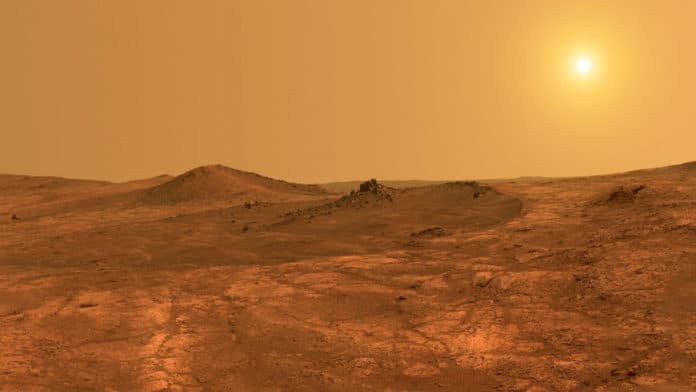Before about 3.8 billion years ago, Mars may have had a denser atmosphere and higher surface temperatures. But today, the current Martian atmosphere is too thin and cold to support liquid water. Plus, the atmospheric pressure is less than one percent of the pressure of Earth’s atmosphere.
How did Mars go from a state potentially more like modern Earth to the desolate inhospitable place it is today?
The past climate on Mars could unravel the answer. A study by a Monash University geologist determines the timing and rates of sediment erosion and accumulation over Mars’ geologic history.
It offers fresh evidence the amount of sand blown into craters on Mars’ surface can be linked to the planet’s temperature history. It could provide new insights into when Mars may have been habitable in geologic time.
The study also quantifies a measure of the erodibility of each of the types of rocks seen on Mars’ surface.
For the study, scientists used multiple datasets to measure the size of crater sand deposits and what produced them. Those datasets include geologic maps, climate simulations, and satellite data. After synthesizing and interpreting the data, scientists understood the controls and timing of erosion on Mars.
Surface rocks are slowly eroded into sediments because of a sedimentary cycle on Earth and Mars. The sediments bury each other, leading to the formation of new rocks, and this process continues to take place. Plate tectonics on Earth recycles the surface, erasing the old sediments across most of the planet. On the other hand, sediment accumulations on the surface of Mars are mostly preserved to the modern-day.
When rocks collide in a liquid, they erode much faster than when they collide in gas since liquids can carry larger, heavier rocks. To produce sediment that can be moved by wind, it must often be broken down into smaller particles by rivers beforehand.
Study author Dr. Andrew Gunn, from the Monash University School of Earth, Atmosphere, and Environment, said, “Seeing high rates of accumulation in a certain period of Mars’ history indicates that it was much more likely there were active rivers eroding material than.”
“Plenty of evidence for surface water in Mars’ past has been published before—meaning there was liquid water on the surface and an atmosphere to sustain it (i.e., conditions more conducive to life)—but the jury is still out on when exactly, and for how long, this occurred.”
Journal Reference:
- Andrew Gunn; Lior Rubanenko; Mathieu G.A. Lapôtre. Accumulation of windblown sand in impact craters on Mars. DOI: 10.1130/G49936.1
